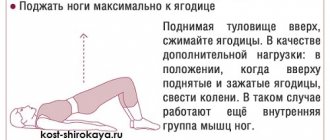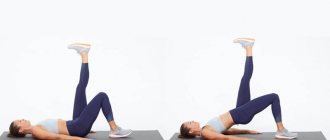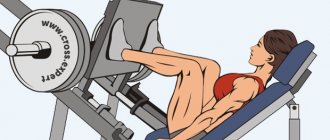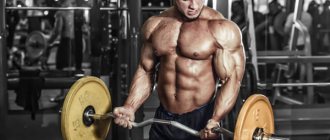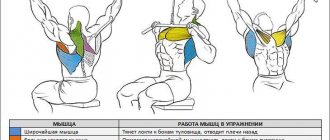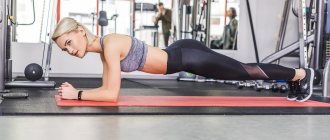Greetings, my readers. There is one wonderful exercise that many people forget about. Even those who regularly engage in fitness and other activities. Meanwhile, it is incredibly useful, accessible, and most importantly, it’s easy to do. And it benefits both your figure and your overall health! This exercise is the gluteal bridge! Next I will tell you in detail and clearly how to do the exercise correctly, what its types are, and what it is all about. And most importantly - what benefits does it bring, and why is it necessary for everyone!
What is a gluteal bridge?
The glute bridge is a multi-joint movement that activates the glutes and stretches the hips. Another name for the movement is pelvic lifts. They are performed on the floor. Why are such lifts needed? Of course, not only for a beautiful, strong butt.
Since the benefits of this exercise are enormous, and are not limited to strengthening the gluteal muscles.
Dr. Stuart McGill, world famous for his research on the spine, in an interview with Strength and Conditioning Journal says: “The gluteal muscles are connected to the pelvis in terms of their biomechanical and anatomical influence. This connection makes this muscle group actually the main power generator.”
Let me break it down for you: hip extension requires the same strength that is needed for many other important movements. For example, for jumping, swinging a bat, running, hitting a ball and many others. This means that the glute bridge can help anyone who plays sports improve their performance. Or maybe become more agile and resilient.
Benefits and features
The gluteal bridge is a universal exercise that is a progressive lift of the pelvis. It helps strengthen and improve the shape of the thighs, increase muscle size, and develop strength and endurance. The exercise technique does not require flexibility or plasticity of the body; even a person with a low level of athletic training can cope with it. With regular exercise of the bridge, the gluteal muscles (large, medium and small) increase in size by 2 times. It is important to consider that the main role here is played by the physiological characteristics of each person. If the goal is to gain seductive rounded buttocks quickly, then the result will directly depend on the regularity and frequency of the exercise.
Here are the muscles that work, besides the gluteal ones:
- calf;
- bark;
- biceps femoris muscle;
- spinal extensors;
- back and front of the thighs.
The gluteal bridge and standard pelvic lift differ in the technique of execution:
- with the classic pelvic lift, the shoulder joint is located on a hill;
- When performing a glute bridge, the shoulder blades are pressed tightly to the floor.
The exercise cannot be considered solely as an ideal means for body correction; it is much more effective. Benefits of doing a glute bridge:
- increased endurance and strength of the gluteal muscles have a positive effect on a person’s gait;
- running and jumping becomes much easier;
- core muscles are strengthened;
- excessive load on the lumbar region is relieved;
- back pain disappears.
When performing a gluteal bridge, the load on the knee joint is minimal, unlike squats.
Gluteal bridge what muscles work?
The main muscles working during this movement are the gluteal muscles: middle, small and large. Additionally, the exercise involves the muscles of the thighs (back and front), as well as the calves, core muscles and spinal extensors.
Varieties of movement allow you to maximize the use of all these muscles.
Types of gluteal bridge:
- with lifting on one leg in the form of a support (one-sided bridge);
- classic traditional (described below);
- with weight (with dumbbells, barbell or plate);
- with elastic at the hips;
- lifting on a bench, on a fitball or on a chair.
But it’s best to start performing the gluteal bridge with the classic version.
This is exactly what I will tell you about.
What muscles are involved?
When performing the glute bridge, many muscles work, as it is a complex exercise. Experienced athletes do it mainly for:
- stretching of the anterior surface of the thigh;
- pumping the gluteal muscles;
- giving tone to the thighs.
Any trainer can tell you how to do the exercise correctly for men and women, but in reality the technique is quite simple, and you can figure it out yourself. It helps to get rid of lower back pain, but it is important to follow the technique. You can watch a video or photo that shows in detail all the nuances of performing a bridge for the buttocks. The benefits of this exercise are multifaceted, as it pumps up many muscle groups and provides a number of benefits:
- The gluteal muscles work without putting pressure on the lower back, which can be contraindicated due to back problems.
- The buttocks are well tightened, as when performing more complex squats.
- The press is pumping.
- The muscles that work when running or long jumping are activated.
- The calf muscles work.
Depending on the chosen technique and additional equipment, you can perform a bridge for the buttocks at home or in the gym. If you read people's reviews about this exercise, you will realize all its benefits.
Gluteal bridge benefits
As I already said, this movement will help make your buttocks firm and beautiful. But the benefits don't stop there:
- spinal muscles will be strengthened, posture will improve;
- the back surface of your hips is perfectly stretched;
- activity is good for the spine - it stretches and strengthens;
- lumbar pain will decrease or even completely go away;
- discomfort and tension in the knee joints will go away;
- your muscle imbalance will be corrected;
- the buttocks will become more voluminous;
- the waist size and “barrel” will decrease;
- in general, you will be able to lose weight, because movement burns calories well;
- the tummy will also shrink and become flatter;
- your shins will tighten, your legs will generally pump up and become stronger;
- plus the muscles needed for running and jumping gain strength;
- blood circulation in the pelvic organs is activated;
- in general, the tone of these organs improves;
- for men, blood activation means improved potency;
- and for women – prevention of all kinds of “female” ailments.
Gluteal bridge - execution technique
Everything here is quite simple. But in order to do everything correctly, it is important for you to know several important nuances and avoid common mistakes. Be sure to do the bridge on a gymnastics mat (rolled, folding) or at least on a regular mat. And don't forget about comfortable clothes.
5 steps on how to do a glute bridge
- Lie on the floor on your back, arms along, legs bent at the knees, feet shoulder-width apart.
- Pull your feet closer to your pelvis, keeping your back in a neutral position.
- Pressing your heels as hard as you can, lift your pelvis up and squeeze your buttocks at the same time.
- Stop at the top for a second or two at the moment when your body from your shoulders to your heels seems to form a line.
- Then start lowering - smoothly, carefully and quite slowly, relax at the bottom, rest for a couple of seconds, and repeat the movement.
Glute bridge with leg raised
By giving yourself one less point of support, you double the difficulty. How to do:
- Starting position: lying on your back, legs bent, feet parallel, hip-width apart. The distance between the heels and the pelvis is about 30 cm.
- Press your head, shoulders and hands tightly to the floor. Raise one leg and straighten it.
- Raise your pelvis 10 cm from the floor and, as you exhale, contract your gluteus maximus muscles, thus opening your pelvis.
- As you inhale, relax your buttocks and return your pelvis to its original position (10 cm from the floor).
- Do this for a minute. Then repeat on the other leg.
Glute bridge with maximum impact
Another important point: when ascending, inhale smoothly, and when descending, exhale slowly and deeply.
The effect will be maximum if you ensure that your amplitude is the same and does not decrease with subsequent repetitions.
You can also do a spinal workout for better results. To do this, first slowly lift the pelvis off the floor. We do this vertebra by vertebra from the tailbone - up. Then the lumbar vertebrae are included in the lifting, followed by the thoracic vertebrae.
When lowering, the sequence is reversed: from the thoracic region to the lumbar region.
We perform the exercise smoothly, without jerking.
To get a good result, you should do 3 sets of 10 times, 3 times a week. You can start with 5 reps, or even 3 if you are a beginner and your level of preparation is weak or simply non-existent.
To strengthen and make your legs stronger, perform a one-sided bridge. With this, one of your legs will serve as a support while standing on the floor. The second will be suspended when the ankle is placed on the knee of the first. So the load falls as much as possible on the first leg. Once done, switch legs.
By the way, if your dream is beautiful, pumped up buttocks, do the same exercise, but with a band on your hips, or with your knees together.
In the second case, you should press your knees as close as possible to each other at the top point. Due to this, the buttocks will simply “burn” and quickly tighten up!
Strengthening the spine with the “Bridge” exercise
The spinal cord is an important part of the human body, which is why training the muscular corset of the back, as well as the flexibility of the spine, gives great benefits to people involved in sports. After all, as you know, damage to the spine can deprive a person of the ability to move.
The spinal column serves as protection for the bone elements and ensures the safety of the spinal cord. Moreover, thanks to the elasticity of the muscles, the spine is able to move, bend and straighten. Regular exercises will ensure flexibility of the spine, which allows a person to fully move and control their movements, and also protects the body from diseases such as osteoporosis, atrophy, and neuropathic pathology.
Pros and cons of the Bridge exercise
By doing workouts 2-3 times a week, you can achieve the following results:
- Increase your back flexibility, thereby improving your posture and strengthening your back muscles.
- Reduce the risk of spinal wear.
- Reduce the likelihood of vertebral displacement.
- Eliminate the possibility of calcium deposits in the area of the cervical vertebrae.
- Improve coordination of movement and functioning of joints.
Despite the large number of benefits, do not think that this exercise can solve any problem associated with back pain. Improper execution of exercise elements can lead to a lot of harm. Severe stretching can lead to painful sensations that will prevent you from exercising for some time.
Before you start doing the exercises, you need to consult a specialist, as he has contraindications. The main diseases are lumbar intervertebral hernia and spinal protrusion.
Why the exercise lost its popularity
Today, there are rarely people who can easily perform a “bridge,” since most people prefer training their arms and abdominals. Despite the fact that instructors in fitness clubs recommend doing exercises for all muscle groups, the “bridge” has lost its popularity. And this is very sad, because the exercise works well not only the back muscles, but also the buttocks and abdomen. The main reason many people refuse this exercise is the difficulty of performing it. It requires support and doesn't fit well with a mix of other exercises.
Instructions for performing the “bridge”
To perform the exercise, you must follow 4 basic rules:
- The ideal execution is considered to be maximum back arching, but many beginners with weak muscles find it difficult to arch their back.
- The correct position of the buttocks is one of the most important conditions. It is necessary to raise the pelvis high, the level of the pelvis should be much higher than the level of the lowered head. Otherwise, the exercise will not be performed correctly.
- Arms and legs should be as straight as possible. To achieve this result, you need to develop the joints, since it is very difficult to take such a position.
- When performing the exercise, you need to breathe evenly and deeply. This will reduce the load on the diaphragm, and breathing will not be interrupted. Experts believe that proper breathing is the key to success.
It is extremely difficult to stand on the “bridge” on the first try; for this you need to prepare your body and start exercising while lying on the floor. However, over time, when your spine gains flexibility, it will be enough to simply tilt your arms back to bend.
5 reasons why you should do the bridge exercise every day
There are many benefits to strengthening the muscles of your back, buttocks and abs. These include not only a beautiful body, on which any clothing will seem ideal, but also a feeling of lightness and health, which increases vitality and strengthens human health.
5 main reasons why you should start mastering the technique of performing the “bridge” exercise:
- Significant reduction in pain in the back and knees. During training, the muscles of the buttocks and subcutaneous tendons are very rarely involved. Usually, when doing household chores and any physical activity, the quadriceps do all the work. Ultimately, relying on one muscle group leads to overexertion and can lead to joint and back pain. In turn, the “bridge” compensates for the work of the quadriceps and engages the posterior muscle chain.
- Sports results will become much better. During the exercise, an important factor is to strengthen the gluteal muscles and core. Strengthened muscles help athletes be stronger, faster and taller than others, in addition, the mobility of a person's joints improves, and household chores do not seem so difficult.
- The clothes fit perfectly. Agree that on a figure with a toned buttocks and a flat stomach, any clothes will look great. Which undoubtedly increases self-confidence and attractiveness. The most noticeable are the strengthened muscles of the buttocks. Using extra weight when training is an advantage, but don't go overboard.
- Development of the core muscles. They are located deep inside the body, their function is to support the spine. By training these muscles, you can provide strong support to the spine.
- Majestic posture and healthy body. Regular exercise will help you keep your back straight throughout the day, regardless of prolonged sitting or standing. The technique is considered quite safe for people with back pain. Recommended for people who lead a sedentary or sedentary lifestyle.
Author: K.M.N., Academician of the Russian Academy of Medical Sciences M.A. Bobyr
Common mistakes
Here are the possible errors:
- the heels cannot be lifted off the floor - on the contrary, they must be “pressed”, as it were;
- It is important not to relax the abdominal muscles, but to tense them at both the upper and lower points;
- keep your neck relaxed and do not lean on it;
- do not move your legs close to your pelvis;
- try to feel every movement, do not do everything simply mechanically;
- below, do not relax completely;
- Do not hold your breath under any circumstances (if you train statics for a while, at the top point of the movement after inhaling, exhale, etc.).
Remember to be careful
Like every activity, this one also has its contraindications. Fortunately, there are few of them. You can safely do the bridge even with severe varicose veins (after all, there is no axial load), with protrusion and even hernia of the spine. By the way, the load on the knee joints here is minimal, so the movement can be safely done by those who have problems with their knees, even serious ones.
The gluteal bridge will be dangerous only for those who are, in principle, prohibited from all activities.
It is allowed even for pregnant women if there are no contraindications to activities in general.
How to implement it into training: recommendations for implementation
- The glute bridge should be performed after compound exercises such as squats, lunges or leg presses. This is an additional exercise for “polishing” the buttocks, so you shouldn’t tire the muscles with it before the base.
- For symmetrical development of the legs, the complex must include exercises for the quadriceps, hamstrings, and buttocks. Since all exercises involve the gluteal group, just one additional exercise, in our case a bridge, is enough to develop harmoniously.
- There is also no need to heavily load the barbell; the purpose of the exercise is to load the muscle, improve its shape and relief if the buttocks are lagging. Therefore, 15-20 repetitions of 3-4 approaches are enough.
